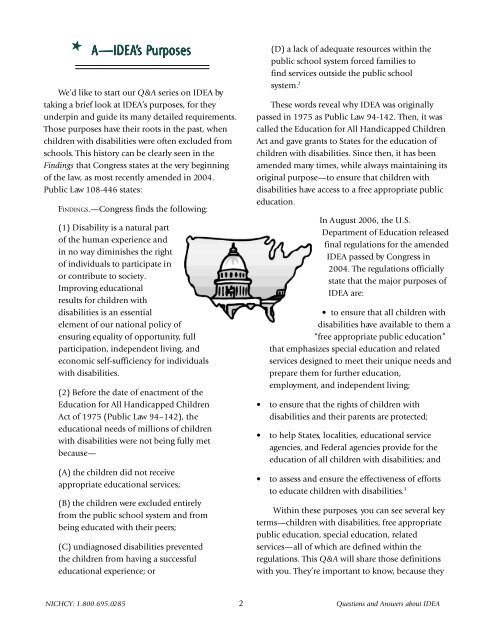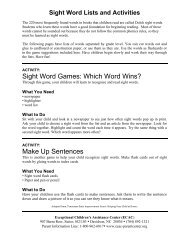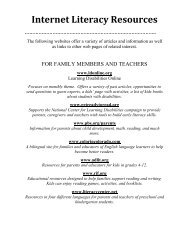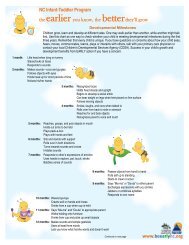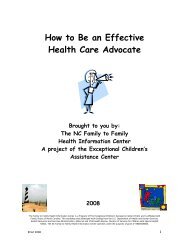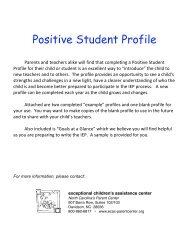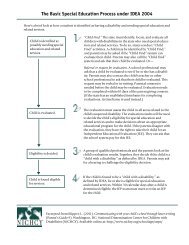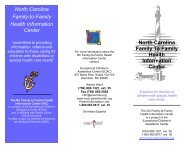Questions and Answers about IDEA - Exceptional Children's ...
Questions and Answers about IDEA - Exceptional Children's ...
Questions and Answers about IDEA - Exceptional Children's ...
You also want an ePaper? Increase the reach of your titles
YUMPU automatically turns print PDFs into web optimized ePapers that Google loves.
★A—<strong>IDEA</strong>’s s PururposesWe’d like to start our Q&A series on <strong>IDEA</strong> bytaking a brief look at <strong>IDEA</strong>’s purposes, for theyunderpin <strong>and</strong> guide its many detailed requirements.Those purposes have their roots in the past, whenchildren with disabilities were often excluded fromschools. This history can be clearly seen in theFindings that Congress states at the very beginningof the law, as most recently amended in 2004.Public Law 108-446 states:FINDINGS.—Congress finds the following:(1) Disability is a natural partof the human experience <strong>and</strong>in no way diminishes the rightof individuals to participate inor contribute to society.Improving educationalresults for children withdisabilities is an essentialelement of our national policy ofensuring equality of opportunity, fullparticipation, independent living, <strong>and</strong>economic self-sufficiency for individualswith disabilities.(2) Before the date of enactment of theEducation for All H<strong>and</strong>icapped ChildrenAct of 1975 (Public Law 94–142), theeducational needs of millions of childrenwith disabilities were not being fully metbecause—(A) the children did not receiveappropriate educational services;(B) the children were excluded entirelyfrom the public school system <strong>and</strong> frombeing educated with their peers;(C) undiagnosed disabilities preventedthe children from having a successfuleducational experience; or(D) a lack of adequate resources within thepublic school system forced families tofind services outside the public schoolsystem. 2These words reveal why <strong>IDEA</strong> was originallypassed in 1975 as Public Law 94-142. Then, it wascalled the Education for All H<strong>and</strong>icapped ChildrenAct <strong>and</strong> gave grants to States for the education ofchildren with disabilities. Since then, it has beenamended many times, while always maintaining itsoriginal purpose—to ensure that children withdisabilities have access to a free appropriate publiceducation.In August 2006, the U.S.Department of Education releasedfinal regulations for the amended<strong>IDEA</strong> passed by Congress in2004. The regulations officiallystate that the major purposes of<strong>IDEA</strong> are:• to ensure that all children withdisabilities have available to them a“free appropriate public education”that emphasizes special education <strong>and</strong> relatedservices designed to meet their unique needs <strong>and</strong>prepare them for further education,employment, <strong>and</strong> independent living;• to ensure that the rights of children withdisabilities <strong>and</strong> their parents are protected;• to help States, localities, educational serviceagencies, <strong>and</strong> Federal agencies provide for theeducation of all children with disabilities; <strong>and</strong>• to assess <strong>and</strong> ensure the effectiveness of effortsto educate children with disabilities. 3Within these purposes, you can see several keyterms—children with disabilities, free appropriatepublic education, special education, relatedservices—all of which are defined within theregulations. This Q&A will share those definitionswith you. They’re important to know, because theyNICHCY: 1.800.695.0285 2 <strong>Questions</strong> <strong>and</strong> <strong>Answers</strong> <strong>about</strong> <strong>IDEA</strong>


